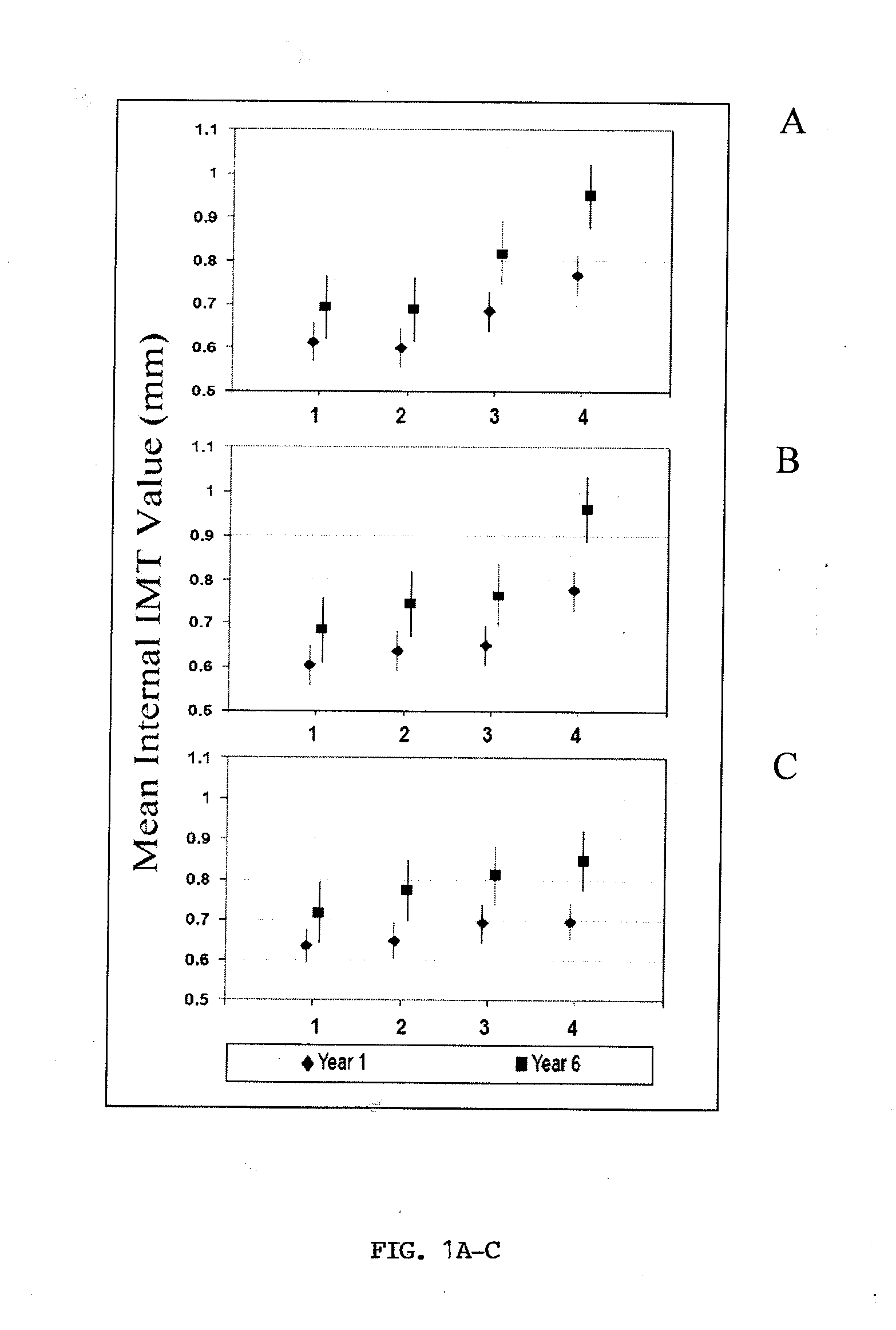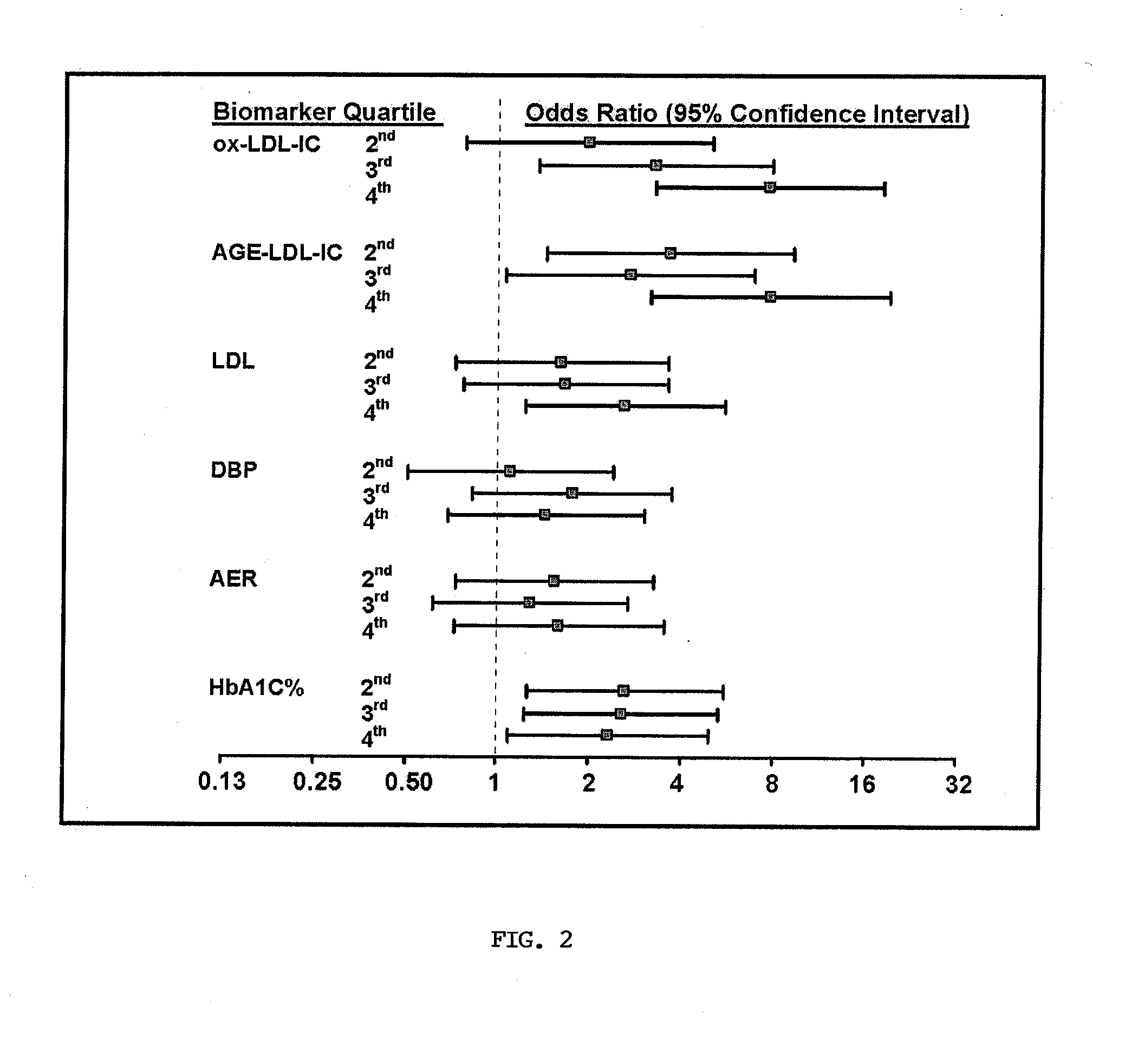Methods For Assessing Modified LDL Immune Complexes in Subjects Having or at Risk of Coronary Artery Disease
a technology of immune complexes and modified ldl, which is applied in the field of molecular biology, can solve the problems of incomplete understanding of their relative roles and inability to adequately assess the predictive value of the i
- Summary
- Abstract
- Description
- Claims
- Application Information
AI Technical Summary
Benefits of technology
Problems solved by technology
Method used
Image
Examples
example 1
Methods
[0137]Subjects. This study was performed on a subgroup of 479 subjects from the DCCT / EDIC cohort. The DCCT cohort included 1,441 patients who were 13-39 years of age and had Type 1 diabetes for 1-15 years at study entry (The Diabetes Control and Complications Trial Res. Group, 1993). None of the patients at entry into the study (1983-89) had hypertension or dyslipidemia and therefore were not on lipid-lowering or anti-hypertensive therapy.
[0138]The DCCT cohort was randomly assigned to intensive or conventional diabetes therapy and followed for an average of 6.5 years. In 1994, after intensive therapy had been demonstrated to have major beneficial effects on microvascular complications, the interventional phase of the study was stopped and the observational phase was initiated (Epidemiology of Diabetes Interventions and Complications (EDIC), 1999). During the ongoing EDIC observational phase, the patients have been under the care of their personal physicians and encouraged to ...
example 2
Results
[0146]At DCCT baseline, the mean age of the study population was 27.1±7.0 years, the mean duration of diabetes was 6.0±4.2 years, 247 (51.6%) of the 479 subjects studied were males and 45.7% were assigned to the DCCT intensive treatment group. Comparing DCCT baseline characteristics of the 479 subjects with the remaining DCCT cohort show that duration of diabetes was longer, they were more likely to have retinopathy at baseline and body mass index and AER were higher. Blood pressure, lipid, and hemoglobin A1c as well as age, gender, drinking and smoking status were similar in those included and excluded in this study's subcohort.
[0147]At DCCT baseline, the levels of oxLDL, AGE-LDL and MDA-LDL in isolated LDL-IC were significantly correlated with diabetes duration, BMI, lipid and blood pressure levels, but not with age. Correlations with LDL-cholesterol while statistically significant were of moderate magnitude (r=0.15 to 0.23, p<0.0007 to p<0.0001). The levels of MDA-LDL, AGE...
example 3
Discussion
[0152]This study has shown that high levels of oxLDL and AGE-LDL in circulating IC, even when measured at a very young age and when the patient is completely free of macrovascular disease, are strongly predictive of increased intima-media thickening over a period of 8-14 years. The associations of the modified lipoprotein levels in circulating IC with internal carotid artery IMT were generally larger than those of classical predictive factors such as albumin excretion rate, LDL-cholesterol, hemoglobin A1c or blood pressure.
[0153]The inter-correlation between the levels of MDA-LDL, AGE-LDL and oxLDL in circulating IC was to be expected, since the precipitated IC are not necessarily made of LDL molecules with single modifications, but rather of LDL molecules with multiple epitopes formed by different mechanisms, recognized by antibodies of different specificities. Furthermore, some of the epitopes, such as CML, are shared by AGE-LDL and oxLDL (Virella et al., 2004). Therefor...
PUM
| Property | Measurement | Unit |
|---|---|---|
| thickness | aaaaa | aaaaa |
| diameter | aaaaa | aaaaa |
| temperatures | aaaaa | aaaaa |
Abstract
Description
Claims
Application Information
 Login to View More
Login to View More - R&D
- Intellectual Property
- Life Sciences
- Materials
- Tech Scout
- Unparalleled Data Quality
- Higher Quality Content
- 60% Fewer Hallucinations
Browse by: Latest US Patents, China's latest patents, Technical Efficacy Thesaurus, Application Domain, Technology Topic, Popular Technical Reports.
© 2025 PatSnap. All rights reserved.Legal|Privacy policy|Modern Slavery Act Transparency Statement|Sitemap|About US| Contact US: help@patsnap.com



